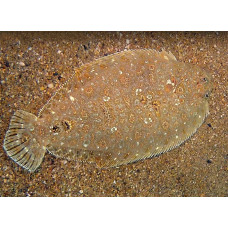Latin name
Bothus ocellatus
Other name
Bothus ocellatus
Identification
It is a flattened, disk-shaped fish. Like other members of this family, it lies on its right side, and as it develops its right eye moves to the left side of the head. Males have a large mouth and the snout has a ridge and a bony tubercle in front of the lower eye. The eyes are large and convex, with the lower one slightly closer to the muzzle than the upper one. There is a fleshy ridge over and behind each eye.
Features of fish fins
The dorsal fin has 76 to 91 soft rays and begins near the upper eye. It is long and resembles a ribbon, and there is a slit between it and the caudal fin. The anal fin has 58 to 69 soft rays and long and distinct from the caudal fin.
Fish colouring
The coloration of this fish is pale brown, gray or brown, with spots, speckles and ring markings, and the fish is capable of changing color depending on the background. It can change color in two to eight seconds. There are three larger dark spots on the straight part of the lateral line and two lighter spots on the tail. It differs from Bothus robinsi in that the tail spots are one above the other, whereas in Bothus robinsi they are one after the other. The underside of this species is pale.
Distribution
Widespread in the western Atlantic, Caribbean and Gulf of Mexico, its range extends from Canada to southern Brazil.
Habitat
The typical habitat of the eye flounder is sandbanks in close proximity to reef thickets, often near areas of coral rubble and seagrass beds. It is usually found in depths down to 50 m (164 ft), but is occasionally found in deeper water, up to 110 m (361 ft).
Size
Eyed flounder reach a maximum length of 18 cm (7 inches), but the more typical size is 12 cm (5 inches).
Behavior
Eyed flounders spend most of their time lying on the seabed, sometimes half-submerged in sediment. They lie motionless, moving only when startled. At night, the larvae are attracted to light, but are difficult to see because they are transparent.
Food and feeding habits
They feed on fish, which make up about a third of their diet, as well as crustaceans such as crabs, mantis shrimp, female shrimp, and amphipods.
Reproduction
Winter breeding occurs near the island of Bonaire. The male eye flounder defends a territory of up to six females, each with their own individual patch. Courtship begins about an hour before sunset and culminates around sunset when the female swims close to the bottom with the male just below. Both release eggs into the water at the same time. The male attempts to mate with each of the females on a daily basis.
When the larvae hatch from the fertilized eggs, they lead a pelagic lifestyle, forming part of the plankton in the open water, and their eyes are initially oriented in a normal symmetrical pattern. As they grow and develop, the eyes move to their adult position on the left side of the head.
Fishing
This species is of minor commercial importance in fisheries.
Relationship with a person
Harmless.
| Classification | |
| Phylum | Chordata |
| Class | Actinopterygii |
| Squad | Pleuronectiformes |
| Family | Bothidae |
| Genus | Bothus |
| Species | B. ocellatus |
| Features | |
| Conservation status | Least Concern |
| Habitat | Pelagic |
| Life span, years | No information |
| Maximum body weight, kg | No information |
| Maximum length, cm | 18 |
| Sailing speed, m/s | No information |
| Threat to people | Not edible |
| Way of eating | Predator |
Eyed flounder
Tags: eyed flounder

